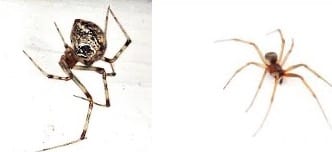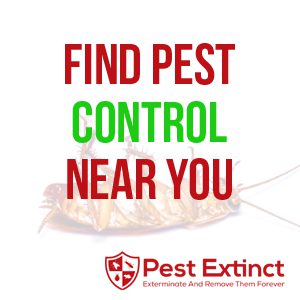
Unraveling the Web: Common Spiders to Watch Out For
Welcome to the latest blog post from Pest Extinct, your go-to source for connecting with top-tier pest control solutions! Today, we’re spinning a web of information about some of the most common spiders you might encounter around your home. Understanding these eight-legged creatures is crucial, especially in distinguishing between the harmless and the potentially harmful.
The American House Spider
Appearance: The American House Spider is a common sight in many homes. They are typically yellowish-brown, with an elongated abdomen, and can be identified by their tangled webs.
Venomous? No. They are harmless to humans.
The Black Widow
Appearance: Instantly recognizable, Black Widows have a shiny black color with a distinct red hourglass shape on their underside.
Venomous? Yes. Black Widows are venomous, and their bites can be painful and medically significant, requiring immediate attention.
The Brown Recluse
Appearance: Brown Recluses are brown with a dark violin-shaped mark on their back. They prefer secluded areas and are not aggressive.
Venomous? Yes. Their venom can cause serious wounds and medical issues, so it’s important to seek medical attention if bitten.
The Daddy Longlegs
Appearance: Known for their extremely long, thin legs and small body, Daddy Longlegs are often found in clusters in damp locations.
Venomous? No. A common myth is that they are highly venomous, but they pose no threat to humans.
The Wolf Spider
Appearance: Wolf Spiders are large and hairy, often mistaken for tarantulas. They have distinctive markings and do not build webs, as they are hunters.
Venomous? No. While they can bite, they are generally harmless to humans.
The Jumping Spider
Appearance: These small, stocky spiders are known for their jumping ability. They have short legs and are often brightly colored or patterned.
Venomous? No. Jumping spiders are not dangerous to humans and are more likely to flee than bite.


The Orb Weaver
Appearance: Orb Weavers are known for their large, circular webs. They come in various colors and sizes, often with unique patterns on their abdomens.
Venomous? No. They are not a threat to humans and are actually beneficial in controlling insect populations.
While some spiders can be a cause for concern, most are harmless and can even be beneficial in controlling pests. At Pest Extinct, we believe in educating homeowners to understand and coexist with these often misunderstood creatures. However, if you ever feel uncomfortable or unsure about the spiders in your home, don’t hesitate to contact us. We connect you with professional pest control companies that can assess and handle any situation with expertise and care.
Preventing Spiders in Your Home: Practical Tips and Strategies
Maintaining a Clean Home
Spiders are attracted to quiet, undisturbed areas. Regular cleaning can go a long way in deterring them.
- Declutter: Reducing clutter eliminates their potential hiding spots. Keep storage areas tidy, and avoid stacking papers or boxes where spiders can nest.
- Dust and Vacuum Regularly: Regular dusting and vacuuming can remove spiders and their webs. Pay special attention to corners, under furniture, and in other less-frequented areas.
Sealing Entry Points
Preventing spiders from entering your home is crucial.
- Inspect and Repair: Check for cracks or gaps in walls, around windows, and doors. Seal these areas with caulk or weather stripping.
- Screens and Door Sweeps: Ensure that window screens are intact and free from tears. Installing door sweeps can also block entry points.
Controlling Food Sources
Spiders feed on other insects. By controlling the population of other pests in your home, you can reduce the food source for spiders.
- Manage Indoor Pests: Regular pest control measures can keep the insect population in your home low.
- Outdoor Lighting: Insects are attracted to light, and spiders follow their prey. Use yellow-tinted bug lights outdoors to reduce the attraction.
Using Natural Deterrents
Some natural substances can help repel spiders. These methods are environmentally friendly and safe for use around children and pets.
- Essential Oils: Oils like peppermint, tea tree, and lavender are known to deter spiders. Dilute with water and spray around entry points and spider-prone areas.
- Vinegar: A mixture of water and vinegar can also be an effective spray.
Landscaping and Outdoor Maintenance
The exterior of your home can also impact spider populations.
- Trim Vegetation: Keep shrubs and trees trimmed back from your house. Spiders can use these as bridges to enter.
- Remove Debris: Regularly clean up leaves, grass clippings, and other organic debris from around your home’s foundation.


Professional Pest Control Services
While these tips can help reduce the presence of spiders, sometimes professional help is needed, especially in cases of venomous spiders or large infestations.
- Regular Inspections: Schedule regular inspections with a pest control professional to identify potential problems and implement preventative measures.
- Customized Solutions: Professional pest control services can offer more targeted and effective solutions tailored to your specific situation and region.
Implementing these strategies can significantly reduce the likelihood of spiders taking up residence in your home. At Pest Extinct, we’re committed to helping you maintain a spider-free environment. Should you need professional assistance or advice, we’re here to connect you with experienced pest control companies. Remember, prevention is key, and we’re here to support you every step of the way.


Leave a Reply